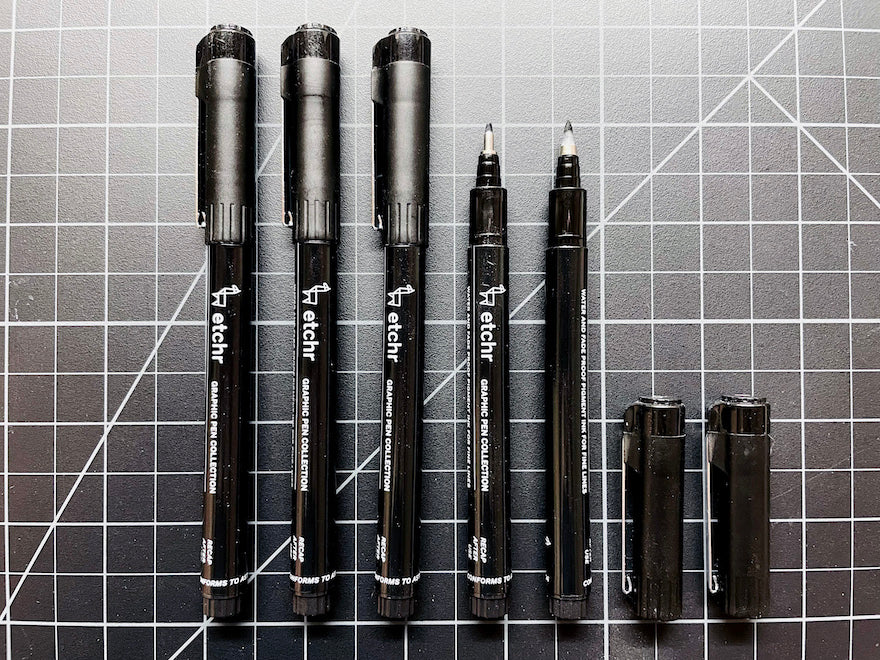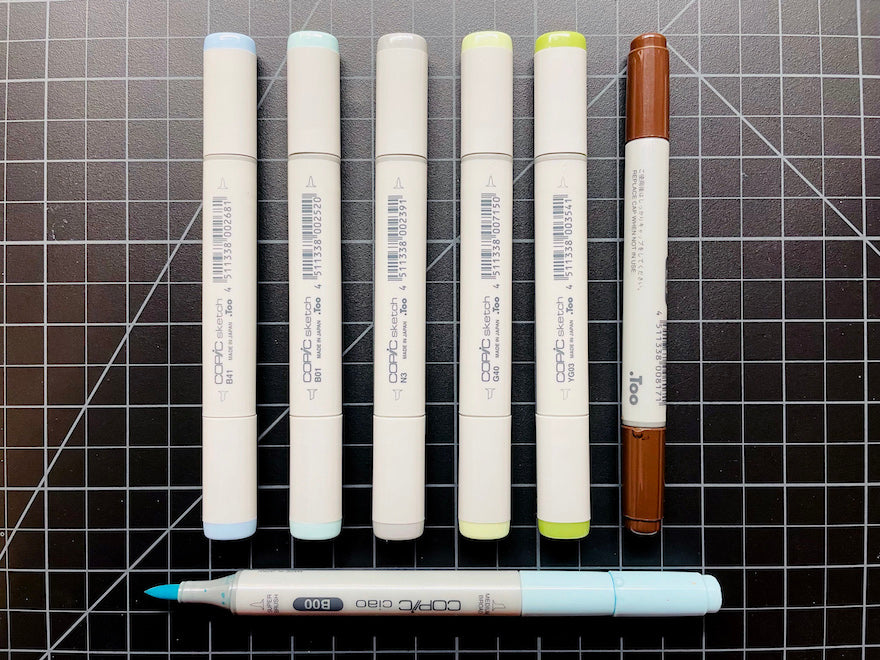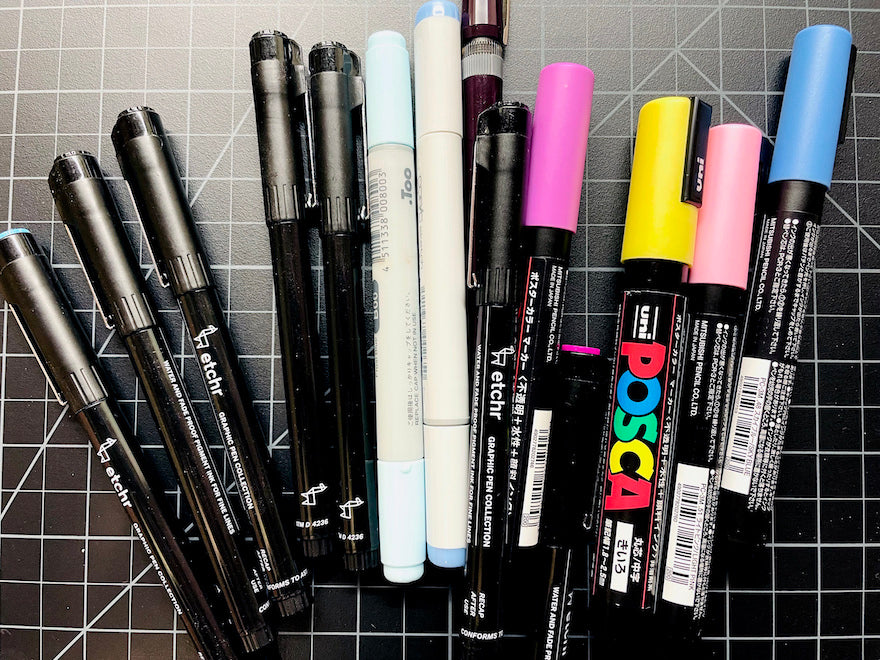My art teacher used to say “A great drawer often makes a great painter”, which is true in the sense that drawing skills help prepare you in terms of understanding shape, form, value, and composition. So it’s no wonder that the graphic pen has been the tool of choice for many sketchers and drawers all over the world!
If you’ve never stepped into the world of pens, here is a quick introduction to the different types of graphic pens, and what makes them click.
Beyond the Written Word
I must confess, the first time I got a graphic pen was to write with it! I just loved the dark ink and the smooth quality of the nib gliding across the page. Ballpoint pens, in contrast, felt “scratchier” to me.
But what is a graphic pen? Also known as a graphic marker, it’s any pen that’s designed for crafters and artists to use when creating illustrations, drawings, or art (i.e. a “graphic”). Of course, they don’t have to be used just for drawing, but their main purpose is to provide a smoother and longer-lasting result than your average pen.
So let’s take a closer look at a few of the main types of graphic pens, shall we
Basic Graphic Pens – Black

The most common is your basic graphic pen. They’re often filled with black ink and are pigment-based to provide an archival (i.e. fade resistant) and waterproof quality. They usually come in different nib sizes and types as well.
They’re like the sturdy, reliable workhorse of the graphic pen world, yet also versatile enough to produce different line shapes and thicknesses. If you’re just starting your drawing journey, I highly recommend having at least one of these pens in your toolbox!

Also, if you’re able to overcome the worry of not being able to erase your lines, it’s quite freeing to scribble down some sketches, especially when you’re out and about. And while shading works a little differently here than it does with pencils, you can still use a cross-hatching or line technique to give the illusion that something’s in shadow.
With the added quality of having waterproof ink, you can also add a layer of watercolour paint over it. I will recommend using a smoother paper (like hot press, mixed media, or Bristol paper) though, just so the pens’ nibs don’t wear out as fast.
Basic Graphic Pens – Coloured

Less common but almost identical to the previous type of graphic pen is your coloured graphic pen, which uses coloured ink instead of black ink. They work pretty much in the same way, only there’s an added element of colour now

While some coloured graphic pens are difficult to layer, others allow a little bit of layering, so you can mix two colours and create an interesting colour “glaze”.
Coloured graphic pens are great for producing coloured outlines, as they offer a lot of control compared to a paintbrush. They’re also consistent in terms of colour, but whether you like this quality or not depends on personal preference.
Bonus tip: A subset of the graphic pen is the technical drawing pen, which is similar but come in very fine nib sizes that are made from metal. This means you can draw very thin lines without worrying about breaking the nib, plus they come with a cartridge that you can refill with ink. The downside is that it can clog easier, so be careful to use the right kind of ink with this pen!
Alcohol Markers

Another relatively popular graphic pen is the alcohol marker. They’re graphic pens filled with alcohol ink, which makes them similar to watercolour paint in that you can blend different colours while the ink is still wet.
This bendable quality makes them the go-to for fashion and car designers, as you can get any colour you can think of if you mix the right ones.

They’re ultra-smooth when applied, though they work best on bleed-proof marker paper as other papers will likely absorb a lot more ink or pill after two layers. They’re also non-archival, as the acidity of the alcohol will cause the paper to yellow faster. I find that the ink tends to run out and dry out faster, which is the opposite of the basic graphic pen that seems to last forever!
However, their ultra-smooth quality makes them perfect for scanning, as any resulting drawing looks very rendered and sleek.
Most alcohol markers now come in 2 tips: chisel and brush, to make it even easier to blend.
Paint Markers

On the newer side, you have the paint marker, which is a type of graphic pen that aims to combine the control of a pen with the thickness of acrylic paint. These markers can be used on pretty much any surface, and when dry, it becomes permanent. Like the alcohol markers, you can do some colour blending while the ink is wet, though, on paper, it dries a lot faster than alcohol markers.

It also destroys the surface of paper much easier than other types of graphic pens, so I highly recommend using thick velum paper, a wooden panel, or even a canvas to draw on.
Like acrylic paint, they’re bright and bold, which makes them great for creating posters or graphics with a more illustrative feel. If this style is right up your alley, why not give them a try?
A Graphic Pen for Everyone

One great thing about graphic pens is that they’re often refillable, so you can save some money (and the environment!) the more you use them. You can also explore a little to find what kind of ink you prefer, and what nib sizes and types suit your art the best.
I hope this has given you a little more insight into the world of graphic pens! And as always, keep on keeping on.
What graphic pens have you tried before? Do you have a favourite type? Let us know in the comments below!
Also, if you’re interested in learning more about the creative process, feel free to subscribe to our email newsletter. Whether you’re experimenting or want to dive deeper into the art world, we’ll notify you of all the latest happenings with Etchr!


